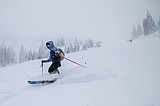Legislation would assist in tribal management of bison
KATE HESTON | Hagadone News Network | UPDATED 2 years AGO
Kate Heston covers politics and natural resources for the Daily Inter Lake. She is a graduate of the University of Iowa's journalism program, previously worked as photo editor at the Daily Iowan and was a News21 fellow in Phoenix. She can be reached at [email protected] or 406-758-4459. | December 20, 2023 11:00 PM
Leaders from the Blackfeet Nation and the Confederated Salish and Kootenai Tribes praised legislation introduced in Congress last month that centers tribal sovereignty into the management of bison herds on tribal lands.
The bipartisan Indian Buffalo Management Act would create a permanent program within the Interior department that assists tribal ownership and management of bison. The bill requires the Interior to sign onto contracts, award grants and provide technical assistance to tribes for activities related to buffalo restoration and management.
“What it would do is solidify the federal government’s trust and responsibility to help tribes restore buffalo,” said Jason Baldes, the senior tribal buffalo program manager at the National Wildlife Federation and the vice president of the Intertribal Buffalo Council.
Similar acts have been introduced into Congress in past years, but Blades said the bipartisan nature of this bill is a positive sign of its possible passage. Members of Montana’s congressional delegation, however, did not sign onto the legislation when it was introduced last month.
“It’s important to help people understand how important the buffalo is to our tribal communities,” Blades said, citing the animal’s spiritual, ecological and nutritional qualities.
The Flathead Valley is between two bison tribal centers: the Blackfeet Nation east of Glacier National Park and the Bison Range on the Flathead Reservation.
Bison are wildlife native to North America but are often called buffalo by Indigenous people, according to the National Park Service. The two terms are often used interchangeably, but the scientific name is bison.
The Bison Range, established in 1908, is a federal trust owned and managed by the Confederated Salish and Kootenai Tribes.
“If this legislation passes, it would create a permanent program within the Interior department, which we deal with all the time, that would promote tribal ownership and management of buffalo and their habitats on tribal lands,” said Rich Janssen, the head of the Natural Resources Department of the Confederated Salish and Kootenai Tribes.
“Bison are one of our first foods that we have a cultural connection to — it's one of those food sources that is most dear to us, we rely on it, and it kind of has a spiritual connection too when we consume it,” Janssen added.
Representatives from the Blackfeet Nation also said the legislation would be beneficial. In July, the Blackfeet released a herd of wild buffalo on tribal land in an effort to restore a free-ranging population in the area, a step toward returning the population to its natural habitat.
“We’ve been working for a lot of years to try and get this passed, even introduced,” said Ervin Carlson, the director of the Blackfeet Buffalo Program and the president of the Intertribal Buffalo Council.
Carlson pointed toward the insurance that the legislation gives to tribes. In the past, funding has remained stagnant. The legislation, he said, solidifies a program to ensure tribes are included in the budget each year.
“All of the tribes are very strapped for dollars to grow their programs and maintain those programs,” he said. “So this would help.”
“I was pleased and happy to see that the Department of the Interior is making some movement on trying to make funds available for tribes,” said Montana Rep. Tyson Running Wolf, D-Browning.
Running Wolf specifically applauded the effort to incorporate cultural knowledge into management practices.
“I’m hoping this opens that door where [the Blackfeet] actually get to use real in-depth spiritual and cultural knowledge on managing the buffalo in harmony and conjunction with the landscape,” he said.
“Nititawahsi” is the Blackfeet name for the tribe’s land and tribal members are called Niitawahsin-nanni: the people of the land where the iinnii (buffalo) live.
Running Wolf did question why no one from Montana’s federal delegation has signed onto the legislation as a sponsor or supporter.
The legislation is sponsored by Reps. Doug LaMalfa, R-California, Mary Peltola, D-Alaska, Tom Cole, R-Oklahoma, Norma Torres, D-California and Jay Obernolte, R-California.
There is a similar piece of legislation that was recently introduced in the Senate as well, sponsored by New Mexico’s Democratic Sen. Martin Heinrich and Oklahoma Republican Sen. Markwayne Mullin.
Reporter Kate Heston can be reached at [email protected] or 758-4459.
ARTICLES BY KATE HESTON

Veteran-owned mobile boat repair service anchors down in the Flathead Valley
The Kramers launched Flathead Mobile Marine to use their skills — they have decades of experience performing routine maintenance checks on a variety of boats as well as working with engines and electrical systems — and help boaters in the community.

With ski season near, resort reaches deal with staff
After 18 months of negotiations, Whitefish Mountain Resort executives and the resort’s ski patrol union are finalizing a one-year contract for the upcoming season.

Trapped in a car wreck, Woods Bay woman credits teens with saving her life
Driving home from a quilting event in Bigfork in September of last year, Carol Martin remembered that the sky was clear, the sun was shining, and she had a headache.

